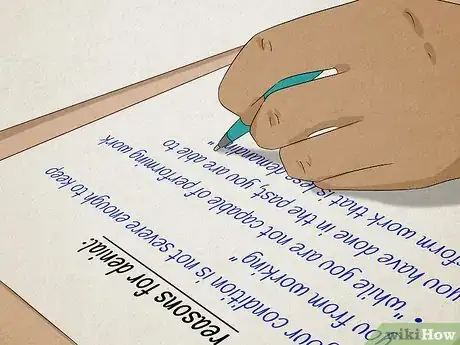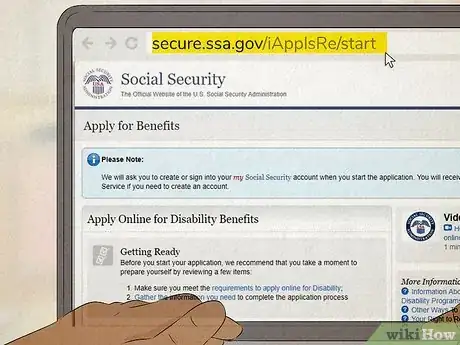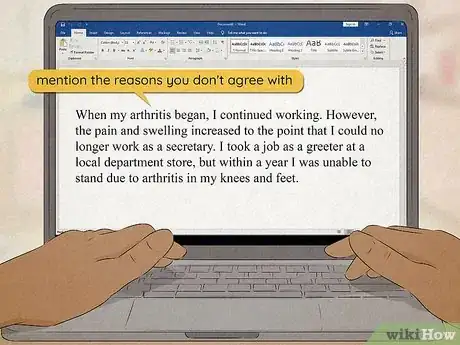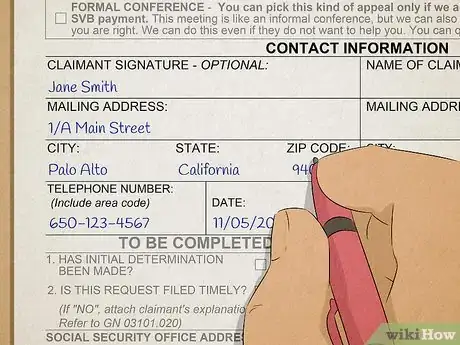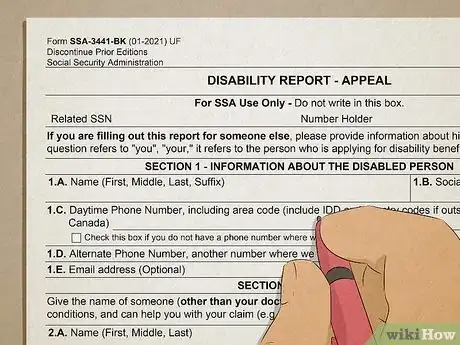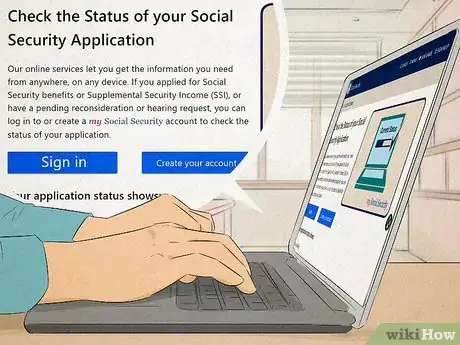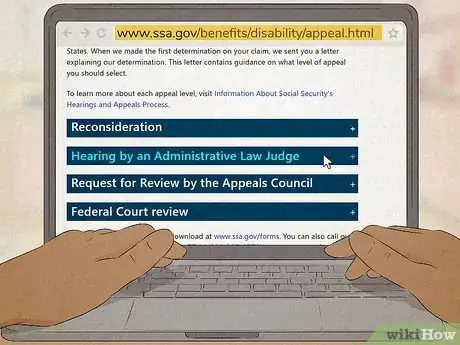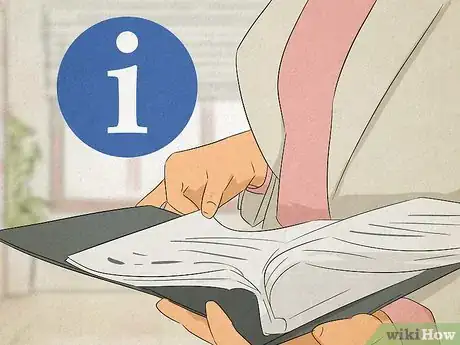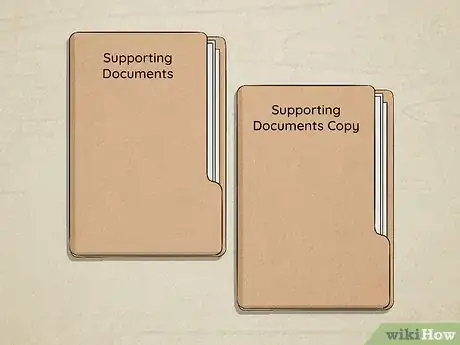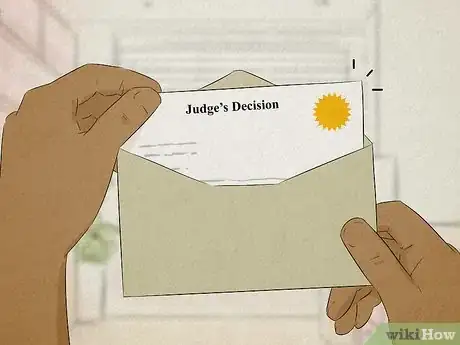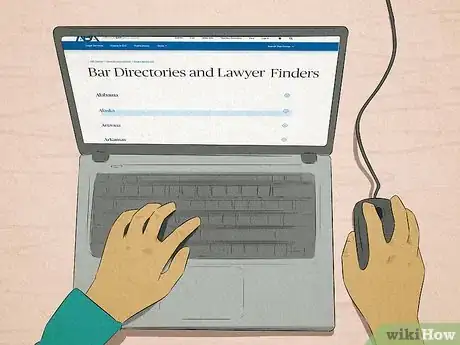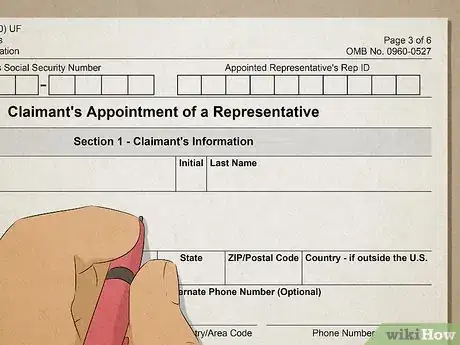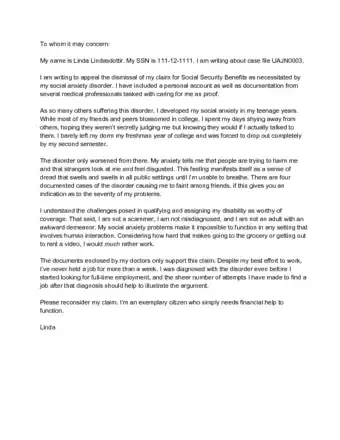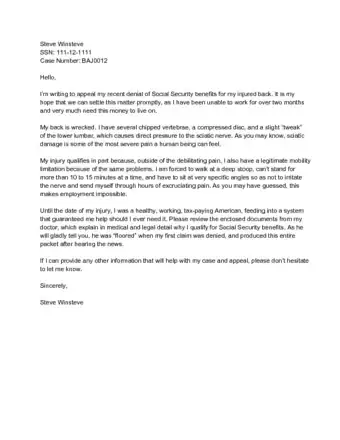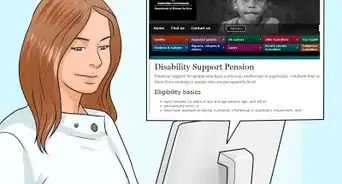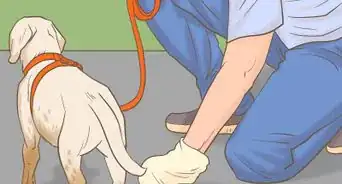This article was co-authored by Jennifer Mueller, JD. Jennifer Mueller is an in-house legal expert at wikiHow. Jennifer reviews, fact-checks, and evaluates wikiHow's legal content to ensure thoroughness and accuracy. She received her JD from Indiana University Maurer School of Law in 2006.
There are 13 references cited in this article, which can be found at the bottom of the page.
wikiHow marks an article as reader-approved once it receives enough positive feedback. In this case, several readers have written to tell us that this article was helpful to them, earning it our reader-approved status.
This article has been viewed 353,847 times.
If you can't work due to a disability, you might be eligible for disability benefits through the Social Security Administration (SSA). If your application is denied, try not to feel defeated. You still have the right to reconsideration, which is where someone else looks over your application. If you still don't get the result you're after, you can request a hearing. Provide plenty of details—backed up with documentation—for your best chance of getting benefits.[1]
Steps
Filing a Request for Reconsideration
-
1Call the SSA if you don't want to file your request online. Call 1-800-772-1213. SSA representatives are available at this number from 7 a.m. to 7 p.m. Monday through Friday. Give them your name and Social Security number, then tell them that you don't want to use the online process but you do want to file a request for reconsideration of your disability claim. They'll walk you through the rest of the process.[2]
- You can also download the form from the SSA's website. Go to https://www.ssa.gov/forms/ and scroll down to "SSA-561-U2 Request for Reconsideration." Click on the blue letters to download the form. You can fill it out online or print it out and fill it out by hand—you'll still need to print it out to sign it.
-
2Write down the reasons for denial written in your notice. The denial letter you got from SSA lists the specific reasons your application was denied. The SSA website has more information about each of these reasons and the factors that go into them. That information can help you determine how to prove the reason is wrong.[3]
- For example, suppose your initial application only showed that you were unable to do the job you had most recently. Disability benefits are only available to people who are unable to do any work, so your application was denied because the SSA determined there was other work you could do. This is a common reason for denial! All you need in this case is information proving that you're unable to do any work.
Advertisement -
3Get documents and information that support your arguments. If the SSA doesn't have all of your medical records, they're more likely to deny your claim. Make sure your records are complete and accurate—doctors don't always write down everything. If your records aren't very detailed, ask your doctor to write a letter supporting your disability claim.[4]
- For example, if you didn't originally submit all of your medical records, the additional medical records could support your appeal, especially if your condition has worsened since your initial application.
- It doesn't hurt to go through the Blue Book (find it online at https://www.ssa.gov/disability/professionals/bluebook/AdultListings.htm) and read what it says about your disability. That's what the SSA is looking for, so try to get information that makes your case look as much like the description in the Blue Book as possible.
-
4Go to https://secure.ssa.gov/iApplsRe/start to start your appeal. Read through the "Getting Ready" section and make sure you have all the documents and information you need. It can take up to an hour to complete your appeal application—longer if you have to stop and hunt down something you need. When you're ready, click the button that says "Start a New Appeal" to get started.[5]
- If you do have to stop at any time, you can save your application and go back to it later. It's also a good idea to save frequently, just in case something happens to your internet connection.
-
5Type out the reasons you don't agree with the denial. Go through the reasons listed on your denial notice one by one and discuss why each is wrong. Be as specific as possible! You never know when a detail you wouldn't consider important could make all the difference. Relate the information you provide directly to the reason for the denial.[6]
- For example, if you were denied because SSA determined you were able to perform other work, you might write: "When my arthritis began, I continued working. However, the pain and swelling increased to the point that I could no longer work as a secretary. I took a job as a greeter at a local department store, but within a year I was unable to stand due to arthritis in my knees and feet."
- If you're using the paper form, you'll notice that there are only a few lines for you to write the reasons you disagree with the denial. Simply write "see attached" and type out your response on separate pages.
-
6Summarize the documents you've attached. Describe what each document is and how it's relevant to your request for reconsideration. If it's new information that wasn't provided in your initial application, mention that as well.[7]
- For example, you might write: "I've attached updated medical records that show my condition has worsened since I initially applied. There's also a letter from my treating physician explaining that, in their medical opinion, I am unable to do any work."
-
7Choose how you wish to appeal. If you choose a case review, an SSA representative will simply go over the documents and information you submit along with the information in your file. The second option is an informal conference, in which you meet with the SSA representative who looks over your claim.[8]
- It's usually best to choose the second option and have an in-person meeting so you can be involved in the process. That way, you can explain your condition to an SSA representative and answer any questions they might have directly.[9]
-
8Provide your name and contact information. Type in your full legal name (as it appears on your Social Security card), address, and phone number. The SSA typically communicates with you in writing, so make sure the address is one where you regularly receive mail (if that differs from your home address).[10]
- Enter your Social Security number, along with your claim number (if it's different than your Social Security number). Check your denial letter—your claim number will be listed there.
- If you're submitting paper forms, there's also a space to sign your name at the bottom.
-
9Fill out a disability report if you're appealing a medical decision. Provide specifics about the conditions that caused your disability and the types of treatment you've received (including names and dosages of any medications you're on). Include the names and contact information for all the doctors and specialists who have treated you for your condition, even if you only saw them once.[11]
- If you're submitting paper forms, go to https://www.ssa.gov/forms/ and scroll down until you see "SSA-3441-BK Disability Report - Appeal." Click on the blue letters to download the form.
-
10Submit your request to the SSA. If you've filled everything out online, you can also submit it online. The website will prompt you to upload any documents you've scanned that you want to include in support of your request.[12]
- If you're mailing printed forms, send them to your local Social Security office. If you need the address, go to https://secure.ssa.gov/ICON/main.jsp and enter your ZIP code.
-
11Check the status of your request online. The easiest way to find out about your request for reconsideration is to go to https://www.ssa.gov/myaccount/ and create an online "mySocialSecurity" account. If you've requested an informal conference, you'll find scheduling information there. When your claim is reconsidered, you can read the results there as well.[13]
- If you don't have internet access or aren't comfortable using the website, you can also call SSA at 1-800-772-1213.
Going to a Disability Hearing
-
1Request a hearing if you disagree with the reconsideration decision. If your benefits are denied after reconsideration, you have 65 days to request a hearing before an administrative law judge. Go to https://www.ssa.gov/benefits/disability/appeal.html to request a hearing online.[14]
- Requesting a hearing follows much the same process as filing a request for reconsideration. Be sure to include any information or documents you've acquired since your request for reconsideration, particularly if they're directly related to the reason your claim was denied.
-
2Check the status of your request online. Go to https://www.ssa.gov/myaccount/ to create a "mySocialSecurity" account so you can easily find out when your hearing is scheduled and communicate with the SSA. You'll also receive a letter in the mail confirming receipt of your request, but checking through your online account is a lot easier.[15]
- The SSA has both in-person and video hearings. When you get your first confirmation letter, you have the option to opt-out of a video hearing, but this usually isn't a great idea—your hearing will typically be scheduled much more quickly if you allow for a video hearing.
- The hearing takes place at a location within 75 miles of your address. If you're going to have trouble traveling to the location of the hearing, let the SSA know as soon as possible—there might be resources available to help you, including money for travel expenses.
- Video hearings take place at more locations than in-person hearings, so it's more likely to be closer to where you live than an in-person hearing.
-
3Look over the information in your file. Going through the information and documentation in your file can help you figure out what might be missing that would help your case. Incomplete records often result in claim denials.[16]
- For example, if your doctor's records are very sparse and don't tell the whole story of your disability, you might want to get a letter from your doctor explaining the extent to which you're disabled and unable to work. You might also have your doctor come to the hearing in person.
-
4Talk to people you want to bring as witnesses. You can bring anyone you want to the hearing who can speak about your disability and the way it impacts your life and your ability to work. Family members, friends, or neighbors who interact with you on a daily basis can all make good witnesses. Your primary care physician and any specialists you see for the condition that caused your disability are also important witnesses.[17]
- Let them know that you want them to be a witness at your hearing and go over what sorts of things they'll probably be asked about. If you've hired a lawyer, they can help you with this—they'll have a better idea of the types of questions the administrative law judge might ask.
- Make sure your witnesses are aware of the date, time, and location of the hearing.
-
5Make copies of documents that support your arguments. You can submit any documents that you think would increase your claim's chances of approval. The SSA will contact you with instructions on how to submit these documents to the administrative law judge before the hearing.[18]
- Keep a copy of all the documents you submit for your own records. That way, you have a complete copy of everything in your Social Security disability file.
- If you request your hearing online, you can also upload digital copies of any new documents you want to submit to the administrative law judge.[19]
-
6Travel to the designated hearing location on the date of the hearing. Even though disability hearings are informal, do your best to look presentable. You don't have to wear a suit, but wear clean, conservative clothes that fit you well. Take all of the documents you have related to your disability claim with you.[20]
- It's a good idea to show up 15 or 20 minutes early so you can find the room where you're supposed to be and get settled before the time the hearing is supposed to start. If you're traveling separately from your witnesses, arrange to meet them out front 15 to 20 minutes early so you can walk into the room together.
-
7Answer questions from the administrative law judge. At the hearing, the judge will ask you questions about your disability, your financial resources, and your ability to work. Answer these questions completely and honestly. If you don't understand a question, ask the judge to clarify before answering.[21]
- If you've brought witnesses, the judge will ask them questions as well. You may also have the opportunity to speak on your behalf or ask the SSA representative there any questions you might have.
-
8Wait for your letter to find out the judge's decision. The judge typically reviews all the information after the hearing, then writes up their decision. You can follow the progress of your appeal through your online account, but you'll usually get a letter within a few weeks.[22]
- If the administrative law judge denied your appeal, there are 2 additional levels of appeal. However, you don't have a right to either of these levels, which means the court can decide not to hear your case. If you still want to appeal after your disability hearing, talk to a lawyer who specializes in Social Security disability appeals.
Getting Legal Help
-
1Talk to friends or family members who are on disability. If you have a friend or family member who is currently receiving Social Security disability, ask them if they used an attorney. If they recommend the attorney they used, that can save you a lot of work trying to find someone.
- You still want to interview the attorney and make sure they're the best for you, though. Choose someone you're comfortable working with—keep in mind you'll be having some frank discussions with them about the nature of your disability.
-
2Reach out to your city or state's legal aid society. Many city and state legal aid societies help people with Social Security disability claims for free, provided you're low-income and meet their other criteria. Even if they don't handle Social Security disability, they can likely put you in touch with other organizations or attorneys who do.[23]
- To find the closest legal aid society, search online for the name of your city or state along with the words "legal aid."
- If you live near a law school, you might check there as well. Many law schools have clinics where law students help people with Social Security disability claims under the supervision of an expert disability lawyer.
-
3Contact your state bar association for a referral. Go to https://www.americanbar.org/groups/legal_services/flh-home/flh-bar-directories-and-lawyer-finders/ and scroll down until you see your state. The link will take you to your state bar association's lawyer referral service.[24]
- These services are one of the best ways to find an attorney who specializes in Social Security disability law. You can also be certain that the lawyers listed here are licensed and in good standing with the state bar association.
-
4Interview several lawyers about taking on your case. Ask specifically what levels of appeal the attorney has experience with. If your application is denied at the hearing level, you want someone who has the knowledge and experience to take your claim further.[25]
- Find out how much experience each attorney has with Social Security disability appeals, especially with cases similar to yours.
- Consider how the attorney makes you feel as well. Do you feel comfortable around them? Do you believe they'll fight for you? Do you trust them? You'll typically do best with an attorney who makes you feel safe and supported.
-
5Discuss payment with the attorney you choose. It's possible you'll find an attorney to help you free of charge. However, if you need to pay your attorney, understand the cost before you commit. Have them breakdown exactly how much you'll be paying them and when payment is due.[26]
- Any fee agreement has to be approved by the SSA anyway, so they shouldn't have any problem drawing this up for you and explaining it.
-
6Tell the SSA that you've hired a representative. Go to https://www.ssa.gov/forms/ and scroll until you see the form "SSA-1696-U4 Appointment of Representative." Click on the title to print it off and fill it out. Sign the form, then submit it to your local Social Security office.[27]
- If your representative isn't an attorney, they also have to sign the form.
- If your representative is an attorney and they're charging you a fee, that fee has to be approved by the SSA before they can take any money from you. Ask them for a copy of the form they submit to the SSA regarding their fees.
Sample Appeal Letters
Warnings
- Don't reapply for SSDI without going through the appeals process. Reapplications are more likely to be denied.[30]⧼thumbs_response⧽
References
- ↑ https://www.ssa.gov/pubs/EN-05-10058.pdf
- ↑ https://www.ssa.gov/hlp/iappeals/other-ways.htm
- ↑ https://www.disabilitybenefitscenter.org/how-to/appeal-social-security-disability-denial
- ↑ https://www.disabilitybenefitscenter.org/how-to/appeal-social-security-disability-denial
- ↑ https://secure.ssa.gov/iApplsRe/start
- ↑ https://www.ssdrc.com/prem31.html
- ↑ https://www.ssa.gov/forms/ssa-561-u2.pdf
- ↑ https://www.ssa.gov/forms/ssa-561-u2.pdf
- ↑ https://michiganlegalhelp.org/self-help-tools/public-assistance/appeals-process-social-security-programs#
- ↑ https://www.ssa.gov/forms/ssa-561-u2.pdf
- ↑ https://www.ssa.gov/forms/ssa-3441.pdf
- ↑ https://www.ssa.gov/hlp/iappeals/other-ways.htm
- ↑ https://www.ssa.gov/benefits/disability/appeal.html
- ↑ https://ctlawhelp.org/en/ssi-ssdi-social-security-disability
- ↑ https://www.ssa.gov/benefits/disability/appeal.html
- ↑ https://www.ssdrc.com/prem31.html
- ↑ https://www.ssa.gov/pubs/EN-05-10058.pdf
- ↑ https://ctlawhelp.org/en/ssi-ssdi-social-security-disability
- ↑ https://www.ssa.gov/pubs/EN-05-10058.pdf
- ↑ https://www.ssa.gov/pubs/EN-05-10058.pdf
- ↑ https://www.ssa.gov/pubs/EN-05-10058.pdf
- ↑ https://www.ssa.gov/pubs/EN-05-10058.pdf
- ↑ https://www.lassd.org/area/ssi
- ↑ https://michiganlegalhelp.org/self-help-tools/public-assistance/appeals-process-social-security-programs#
- ↑ https://ctlawhelp.org/en/ssi-ssdi-social-security-disability
- ↑ https://www.ssa.gov/pubs/EN-05-10075.pdf
- ↑ https://www.ssa.gov/pubs/EN-05-10075.pdf
- ↑ https://secure.ssa.gov/apps10/poms.nsf/lnx/0203101020
- ↑ https://www.ssa.gov/forms/ssa-561-u2.pdf
- ↑ https://www.disabilitybenefitscenter.org/how-to/appeal-social-security-disability-denial
About This Article
To write an appeal letter to Social Security Disability, start by stating that you’re appealing your decision and that you have additional documentation, like medical records, to support your claim. Follow up with 1 or 2 paragraphs to explain how your symptoms have worsened over time. Additionally, explain how your condition makes you unable to work any kind of job, not just your old job. Then, complete the required forms that were sent with your denial notice, and mail them along with your appeal letter and supporting documents to the address provided to you. For more advice, including how to fill out the SSA forms you’re required to submit with your letter, keep reading.

